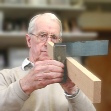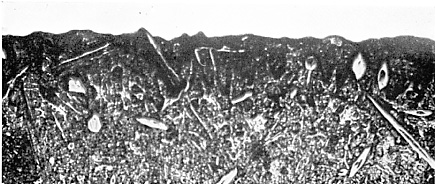

It was an excellent knife, it cut before it touched.
Understandably, people can appear to spend inordinate amounts of time in forming 'the perfect edge', yet it is clear that even the best edge begins to break down from the first plane or chisel stroke. Long before it is completely useless the edge will increasingly leave very fine striations ("signatures" to the old hand craftsmen) on the surface.
From the introduction: "Past study has shown, however, that serious errors may occur in estimating the blunting property of a timber if the cutting edge of the tool is fractured during the early stages of its useful life and, in consequence, does not wear away evenly. The examination of blunted cutters has shown that these premature fractures often originate at small nicks in the edge formed by face scratches during honing. This suggests that the extra load consequently exerted at these points in the cutting process tends to break away the metal.”
One can conclude that if this applies generally, the coarseness/fineness of the abrasive plays a part in edge durability as well as edge keenness.
"Cutter sharpening was undertaken first with 800-grade aluminium oxide powder lubricated with water containing a wetting agent, but as it tended to produce relatively deep nicks in the edge, it was necessary to use material having a smaller particle size for the final lapping" (using a honing jig on glass). ................. "Polishing of the lapped surfaces further improved the quality of the edge and was effected by using a proprietary brand of liquid silver polish in place of the aluminium oxide powder."
"The rapid reduction that occurs in the thickness of the abrasive-water mixture as it passes under an advancing metal surface is responsible for the scoring of the surface near its leading edge. This scoring interfered seriously with the sharpening of the tools unless it was eliminated from the cutting edge by employing an intermittent lapping action in which the cutter ............had no pressure exerted on it during the forward travel of the cutting edge".
"The sharpening of the cutter was considered satisfactory if the edge were capable of cutting a hair on the back of the hand and if no nicking of the edge and no contigous scratching of bevels were revealed by an examination of the tool magnified 90 times".
In another document, they imply that edges so produced have a thickness of about 1 - 2 microns (1 micron = a thousandth of a millimeter = 0.00004")
"Although the strength of a cutting edge depends primarily on the size of the sharpness angle, careful sharpening of the edge also reduces its tendency to fracture by reducing the number and size of nicks, which are a source of weakness."
Anyway, it is obvious that they considered that nicks play a part in edge disintegration.
For several years I have been sharpening, using a jig, first on an ordinary medium Aloxite oilstone (now replaced by a diamond plate) and finishing on glass using a liquid chromium polish to form a 'microbevel' at about one degree higher angle to the Aloxite-honed bevel.
I only have a 10 times magnifier, but can see that after 30 - 40 rubs this removes the deeper scratches from the Aloxite but leaves some much finer ones on what to the naked eye seems a polished bevel.
Edges pass the hair shaving test without difficulty, and also will cut lightly suspended tissue paper.
I've adopted this approach simply allowing the glass/chromium cleaner surface to replace the fine natural stone I used for many years. The edge will not be as perfect as those formed above, but it is certainly more polished than those I formerly had. There may be academic justifications for using a series of increasingly fine abrasives, but time economy is not one of them.
I think that this approach is a reasonable pragmatic compromise. However, as far as I can detect, few are impressed by the idea - maybe the feel of the tool on the glass is unfamiliar?
